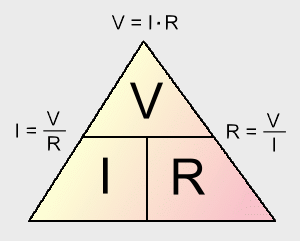 Ohm's Law describes the mathematical relationship between current, voltage, and resistance in an electrical circuit. It was discovered by Georg Simon Ohm in 1827. An electric circuit is formed when a conductive path is created to allow electric charge to continuously move. This continuous movement of electric charge through the conductors of a circuit is called a current, and it is often compared to the flow of a liquid through a hollow pipe. The force causing charges to 'flow' in a circuit is called voltage. Voltage is a specific measure of potential energy that is always relative between two points. A certain amount of voltage being present in a circuit is a measurement of how much potential energy exists to move charges from one particular point in that circuit to another particular point. Current tends to move through the conductors with some degree of friction, or opposition to motion. This opposition to motion is more properly called resistance. The amount of current in a circuit depends on the amount of voltage and the amount of resistance in the circuit to oppose current flow. Just like voltage, resistance is a quantity relative between two points. For this reason, voltage and resistance are often stated as being 'between' or 'across' two points in a circuit. Current I is measured in amperes (amps), unit A Voltage V is measured in volts, unit V Resistance R is measured in ohms, unit Ω Each unit of measurement is named after a famous experimenter in electricity: The amp after Andre M. Ampere, the volt after Alessandro Volta, and the ohm after Georg Simon Ohm. Ohm's Law Ohmís discovery was that the amount of electric current through a conductor in a circuit is directly proportional to the voltage impressed across it, for any given temperature. Ohm expressed his discovery in the form of a simple equation, describing how voltage, current, and resistance interrelate: V = I·R This can be rearranged to solve for each of the three values: V = I·R I = V/R R = V/I Here is an example of how to use Ohm's Law: "A simple circuit has a 36 V battery, and the current in the circuit is 4 A. Find the resistance". R = V/I R = 36/4 R = 9 Ω Here is a triangle diagram to help you remember the three rearrangements of Ohm's formula: 
|